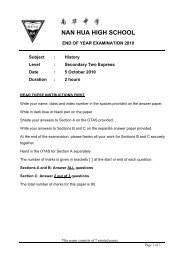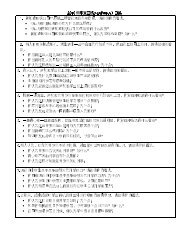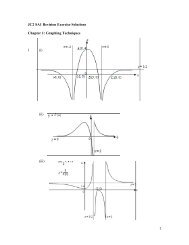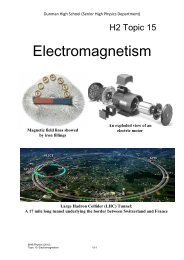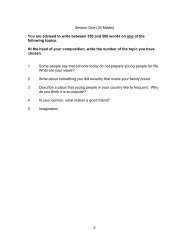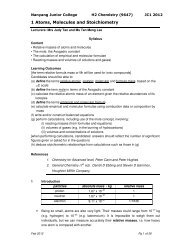Suggested Answers of BT2 Revision Package - ASKnLearn
Suggested Answers of BT2 Revision Package - ASKnLearn
Suggested Answers of BT2 Revision Package - ASKnLearn
- No tags were found...
Create successful ePaper yourself
Turn your PDF publications into a flip-book with our unique Google optimized e-Paper software.
(ii)With reference to the data, assess whether the rising rupee poses athreat to India’s exports.Thesis - theoretical analysis <strong>of</strong> likely fall in Xs given a stronger currencyCeteris paribus, a rising rupee would lead to a higher foreign currencyprice <strong>of</strong> India’s exports which would dampen the demand for India’sexports. This concern about India’s export competitiveness was raisedin Extract 6 ‘…pressures on competitiveness likely to arise from anyemergent currency appreciation pressures.’Anthesis – however, Xs did not fallShown in Fig. 2• As shown in Fig.3 and also stated in Extract 6, overall the rupeeappreciated since 1992 (mildly by about 3%) while India’s share inworld goods exports has roughly doubled. Moreover, the trendpersisted over a long 15-year period with a higher rate <strong>of</strong>improvement in India’s share <strong>of</strong> world goods exports.India’s non-price competitiveness or rising rupee due to better exportperformance• In addition to the exchange rate, there are likely other factorsinfluencing India’s export competitiveness.• While a stronger rupee may erode India’s price competitiveness, Indiacould have improved its non-price competitiveness in terms <strong>of</strong> qualityor product image. India’s comparative advantage in highly-skilledlabour could also be moving up in value-addedness towards high-techindustries in information technology. In other words, India’s exportperformance could well be the reason behind the rising rupee asIndia’s exports become more competitive and enjoy rising demand.• This is implied in Extract 6 stating ‘the need for ‘continued’ efforts tomaintain strong productivity growth to cope with any pressures oncompetitiveness likely to arise from rising rupee’. To the extent thatIndia is able to maintain its strong productivity growth to support therising rupee, erosion <strong>of</strong> its exports competitiveness from a risingrupee is limited.Difference between nominal and real effective exchange rate• In Extract 6, the concerns raised about competitiveness due tosignificant appreciation <strong>of</strong> rupee during 2007 ‘In nominal terms… particularly notable… ‘ was clearly referring to theappreciation in nominal terms.• Hence, the comment that export performance remainedfavourable despite the significant rupee appreciation could bebecause <strong>of</strong> a lower inflation rate <strong>of</strong> India’s exports relative to theweighted average inflation rate <strong>of</strong> imports it buys from othercountries. In other words, India’s real exchange rate <strong>of</strong> rupeecould have fallen.[5]




